
- Home
- Art Movement
- Authenticity
- Characteristics
- Boxed (2)
- Framed (25)
- Framed, On Canvas (11)
- Framed, On Panel (2)
- Framed, On Wood (38)
- Framed, Signed (4)
- Miniature (3)
- On Canvas (8)
- On Panel (28)
- On Wood (131)
- On Wood, On Canvas (6)
- On Wood, On Panel (15)
- On Wood, Signed (3)
- Signed (14)
- Signed, On Canvas (15)
- Signed, On Panel (10)
- Signed, On Wood (58)
- Other (4666)
- Genre
- Abstrait (59)
- Académisme (57)
- Art Déco (50)
- Barbizon (27)
- Baroque (87)
- Classicism (76)
- Classicisme (225)
- Expressionism (158)
- Expressionnisme (160)
- Fauvism (35)
- Fauvisme (53)
- Impressionism (185)
- Impressionnisme (497)
- Impressionniste (33)
- Orientalisme (74)
- Orientaliste (26)
- Realism (63)
- Renaissance (28)
- Romantisme (116)
- Réalisme (204)
- Other (2826)
- Theme
- Abstract (7)
- Animals (28)
- Architecture (8)
- Character (64)
- Child (5)
- Flower, Tree (15)
- Genre Scene (39)
- History, War (5)
- Horse Portrait. (2)
- Hunting, Fishing (5)
- Landscape (321)
- Landscape Riverbank (2)
- Marine (3)
- Marine Landscape (2)
- Nude (2)
- Nude Woman (2)
- Portrait (9)
- Religion, Mythology (23)
- Seascape, Boat (53)
- Still Life (50)
- Other (4394)
- Type
Oil on wood Landscape Signed Léon Couturier 19th century
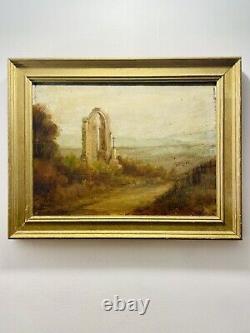
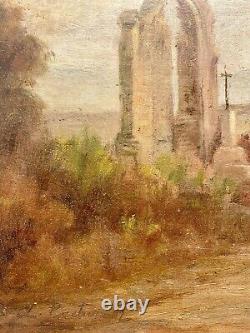
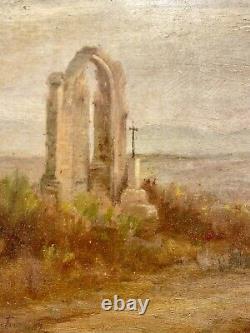
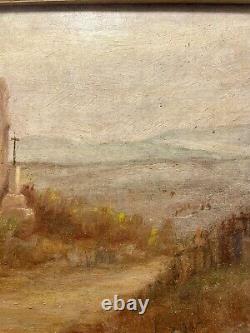
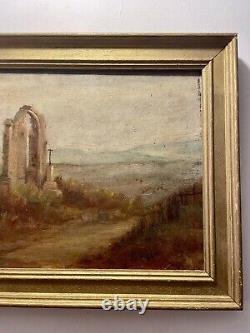
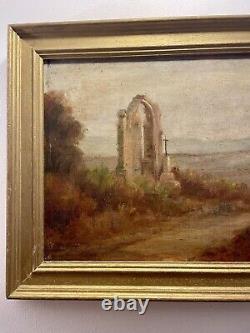

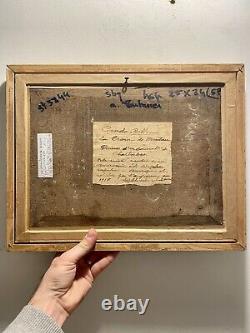

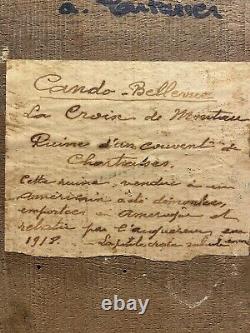



Oil on wood Landscape Signed AL Couturier, most likely from the end of the 19th century. Attributed to Léon Antoine Lucien Couturier born on December 29, 1842 in Mâcon and died on December 21, 1935 in Neuilly-sur-Seine was a French painter.
This painting of historical interest represents the Chartreuse of Villeneuve: Croix de Montaut or Belle Croix (now disappeared - territory of Villeneuve). The monument left France in the 1920s to join the United States.
Located on the heights of Villeneuve les Avignons, on the site of the former Gallo-Roman road, was a covered cross called the Belle-Croix de Montaut. Built in the middle of the 14th century in the form of a quadrilateral building 8 to 9 m high, opened on each side by a vast ogival arcade, the oratory was a high place of prayer for all pilgrims who were preparing to make Santiago de Compostela. Following the wars of religions, only an arch classified as historical monuments by an 1883 decree will remain of this small Gothic chapel. "This elegant edicle of the 14th century is very mutilated, but what remains of it is of great interest from the point of view of the provisions and the plan, " notes on the minutes.. Wooden frame 40x31 cm with frame and 32x23 cm off frame. Attached to the naturalism movement, he specialized in maritime and military subjects.Superb landscape at the monument (an arch) and La Croix with an interesting light. Son of Louis Marie Couturier, a negotiator, and Jeanne Marie Fontanelle, Léon Couturier was admitted to the École des beaux-arts de Lyon in 1860, then went to Paris in 1864 where he was a student of Alexandre Cabanel's studio. He participated in the defense of the capital during the siege of Paris by the Prussians in 1870.
This traumatic experience of war and defeat is the source of inspiration for a first series of paintings devoted to conflict, then to the representation of soldiers and military life. A stay in North Africa seems to be at the origin of a number of works dedicated to colonial troops. These productions earned him marks of official recognition. Appointed Navy painter in 1890 and decorated with the Legion of Honor on December 31, 1897, he received public commissions for paintings.He chew French soldiers during the First World War. At the end of his life, his painting abandoned warships for fishing and fishermen. He regularly exhibited at the Salon des artistes français of the Société nationale des beaux-arts and obtained a 3rd class medal in 1881. He also received a bronze medal at the Universal Exhibition in Paris in 1889 and at the Universal Exhibition in 1900.

